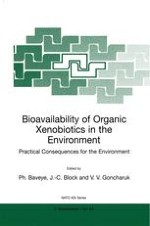1999 | OriginalPaper | Chapter
Limited Bioavailability of Organic Contaminants in the Environment: Policy Implications
Author : W. Verstraete
Published in: Bioavailability of Organic Xenobiotics in the Environment
Publisher: Springer Netherlands
Included in: Professional Book Archive
Activate our intelligent search to find suitable subject content or patents.
Select sections of text to find matching patents with Artificial Intelligence. powered by
Select sections of text to find additional relevant content using AI-assisted search. powered by
The concept of non-extractable organic residues is well accepted in the EU-legislation for pesticides. Making pollutants less bioavailable by increasing physical sorption represents a pragmatic approach to contractors and regulators. For organic pollutants with acceptable concentration in the soil solution of the order of 1 mg/1, a sorptive loading of the order of 10 000 mg pollutant per kg activated carbon respectively organic matter appears a workable assumption. In case of toxic substances such as pesticides which have a 1000 times lower acceptable level, a sorptive loading of up to 10 mg organic pollutant per kg sorbent can be used. Non-bioavailable pollutants can be considered as representing no direct harm to the environment. In practice, the application of up to 100 – 200 kg dry weight quality compost per ton dry weight soil or alternatively the supplementation of other sorbents such as powdered activated carbon (up to 100 kg per ton soil) offers possibilities to cost-effective remediation of organic pollutants.
